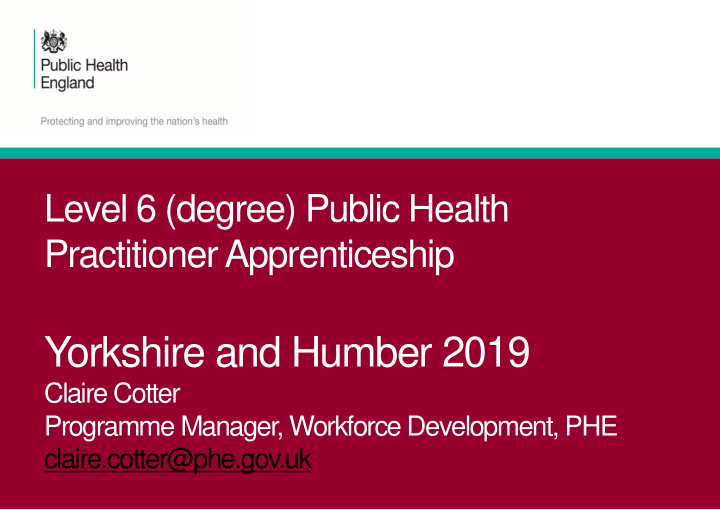



Level 6 (degree) Public Health Practitioner Apprenticeship Yorkshire and Humber 2019 Claire Cotter Programme Manager, Workforce Development, PHE claire.cotter@phe.gov.uk
the brief………… the development of the Public Health Practitioner apprenticeship from concept to approval how did this all start ………? 2
the journey Public Health Apprenticeships – ‘exploring the possibilities’ workshop 23rd MAY 2017 convening an employer trailblazer group August 2017 preparing and submitting an occupational proposal ( approved Dec 17 ) preparing and consulting on a draft standard ( July 2018 ) revising and submitting the apprenticeship standard ( approved November 2018 ) preparing and submitting the End Point Assessment (EPA) and funding application ( approved Sept/Oct 2019 ) 3
level 6 (degree) PHP (36mths) 4
key points • it is a generic standard i.e.: an apprentice completing the programme and successfully being assessed as ‘occupationally competent’ will be employable by any of the employing organisations • it has been drafted by a group of employers, and universities who have developed, or are offering, BSc (Hons) in public health • it has been written for a wide audience including school leavers and their parents/carers/teachers/mentors requiring us to resist the urge to use technical or specialised language • the UKPHR is fully sighted on the alignment of the apprenticeship standard to the standards for occupational competence (practitioner professional registration standards) 5
what is an apprenticeship? https://www.ukphr.org/level-6-degree-apprenticeship-standard-for-public-health-practitioners/ 6
characteristics of the PHP standard • Level 6* • Integrated degree This was agreed by the trailblazer members – employers, HEIs and the professional bodies. This means that the End Point Assessment is embedded as part of the degree programme – this means that the apprentice will not be able to complete the degree without passing the EPA. The provider university will be responsible for the delivery of the EPA but it must be carried out impartially. * https://www.gov.uk/what-different-qualification-levels-mean/list-of-qualification-levels 7
characteristics of the PHP standard • 36 months (typically) duration • developed to meet requirements for professional registration and the occupational competency required through the practitioner standards • duties of the standard written around the 13 functional areas of the PHSKF with a 14 th duty related to professional and ethical practice (KSBs – knowledge, skills and behaviours are written for all 14 duties) 8
pre-requisites for a quality apprenticeship • transparent and documented agreement between the employer, the apprentice and the education Apprentice provider • an employer creates a job opportunity and pays the salary for the duration of the apprenticeship, drawing on the levy to procure the educational element from an IfA approved provider (money goes from the levy ‘pot’ to the provider) Provider Employer • NB: large levy paying organisations can make some of their levy available to smaller organisations 9
pre-requisites for a quality apprenticeship • clear mechanisms and commitment to support the apprentice on their journey – arranging the necessary placements or work experience; providing adequate supervision for skills development; tutorial support for the educational elements; performance management of the apprentice through joint efforts of the employer and the provider 10
gateway • employer is satisfied that the apprentice is consistently working at, or above, the level of the occupational standard • English/Maths Level 2 • apprentice has achieved 330 credits of the degree programme (the last 30 credits are allocated to the EPA) • apprentice submits a portfolio of evidence to the End Point Assessment Organisation (EPAO) (university provider though the EPA must be carried out by assessors who have had no previous involvement with the apprentice) NB: the portfolio will form the basis of the first assessment method 11
End Point Assessment (EPA) All of the KSBs in the standard need to be assessed as part of the EPA – they only need to be assessed once, so they will be divided between the two assessment methods. Several can be assessed during the same activity. The assessment methods do not have to be delivered on the same day. 1. Presentation of practice with question and answer session : 40 minute presentation with 40 minute Q&A based on the portfolio of evidence submitted to proceed through gateway. The EPAO reviews the portfolio and sets a presentation title and brief for the apprentice. 2. Scenario-based situational judgement test : a competency based assessment of knowledge, skills and behaviours through five 25 minute activities, with 5 minutes between each activity on a circuit. Total time for this methods can not exceed 150 minutes. 12
implications for universities • most degree apprenticeships are only viable if the university offers a parallel offer to apprentices on existing degree programmes (i.e. developing a different programme just for apprentices won’t work) • this ‘pathway’ will need to be validated by the university i.e. the programme will need to be revalidated which takes time and planning • the mode of delivery will need to be through blended learning if it is going to meet the needs of employers and if the apprentices are dispersed i.e. a predominantly classroom based programme will not work 13
14 The Revised Public Health Skills and Knowledge Framework 2016
Recommend
More recommend